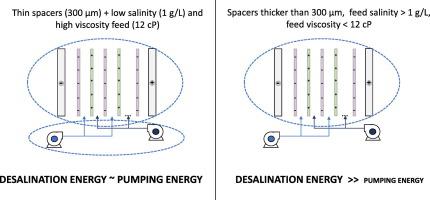Desalination ( IF 9.9 ) Pub Date : 2021-04-20 , DOI: 10.1016/j.desal.2021.115091 P.A. Sosa-Fernandez , T.M. Loc , M. Andrés-Torres , M. Tedesco , J.W. Post , H. Bruning , H.H.M. Rijnaarts

|
When performing electrodialysis (ED) to desalinate a stream, both the energy for desalination and the energy for pumping contribute to the total energy consumption, although under typical working conditions (e.g., brackish water desalination) the latter is usually negligible. However, the energy penalty might increase when desalinating viscous mixtures (i.e., viscosity of 2–20 cP). In this work, we experimentally investigate the desalination performance of an ED-unit operating with highly viscous water-polymer mixtures. The contribution of desalination and pumping energy to the total energy consumption was measured while varying diverse parameters, i.e., salinity and viscosity of the feed, and geometry and thickness of the spacer. It was found that the type of spacer did not significantly influence the energy required for desalination. The pumping energy was higher than predicted, though in most cases minimal compared to the energy for desalination. Only when using thin spacers (300 μm) and/or highly viscous feeds (12 cP), the pumping energy accounted for 50% of the total energy for low salinity feeds. Therefore, the main contributor to the energy consumption of viscous solutions is the desalination energy, provided that large spacer thicknesses (at least 450 μm) and adequate operating conditions are utilized to limit pumping energy losses.
中文翻译:

电渗析器淡化聚合物水溶液的能耗
当执行电渗析(ED)来使物流脱盐时,用于脱盐的能量和用于泵送的能量均会消耗总能量,尽管在典型的工作条件下(例如微咸水脱盐),后者通常可以忽略不计。但是,当淡化粘性混合物时(例如,粘度为2–20 cP),能量损失可能会增加。在这项工作中,我们通过实验研究了使用高粘度水-聚合物混合物操作的ED装置的脱盐性能。在改变各种参数(即进料的盐度和粘度以及间隔物的几何形状和厚度)的同时,测量了脱盐和泵送能量对总能耗的贡献。发现隔离物的类型没有显着影响脱盐所需的能量。尽管在大多数情况下,与脱盐所需的能量相比,泵送的能量要高于预期的能量。仅当使用薄垫片(300μm)和/或高粘度饲料(12 cP)时,泵送能量才占低盐度饲料总能量的50%。因此,如果利用大的隔离层厚度(至少450μm)和适当的操作条件来限制泵送的能量损失,那么对粘性溶液能耗的主要贡献就是脱盐能量。


























 京公网安备 11010802027423号
京公网安备 11010802027423号